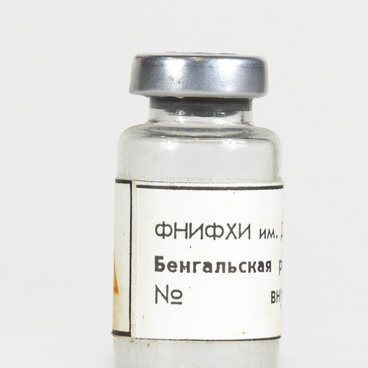The hagiographic icon of Saint Mitrophan, Bishop of Voronezh is unique both in terms of its content and because it bears the artist’s signature and the date when it was painted. The icon of Saint Mitrophan of Voronezh was painted on the occasion of the 150th anniversary of his death. By that time the bishop had been canonized by the Russian Orthodox Church. At the bottom of the icon are the inscriptions: “Painted by Ivan Ivanov Ivanov”, “This icon was painted in 1853 on the 23rd day of November”. On that day thousands of pilgrims were walking to the tomb of the saint in the hope of receiving healing and solace. Ivan Ivanov painted the icon for the Church of Saint George in Kaluga region, to which he belonged as a parishioner. The relic was handed to the museum in the 1970s by Faina Leonova-Ivanova, a former pupil of the “Vigorous Life” colony, whose husband was a descendant of the iconographer.
In the center of the icon is the elder Mitrophan in a bishop’s robe with golden tablets. With one hand he blesses those praying and with the other holds the staff, a symbol of power. On the head of the saint is an ascetic koukoulion, instead of the bishop’s miter. This is a peculiarity of Saint Mitrophan’s iconography, by which his image can always be recognized. He took the ascetic schema shortly before his death, a monastic vow that implies strict asceticism and renunciation of earthly authority and honors.
In 1703, Peter I learned of Saint Mitrophan’s illness and came to Voronezh. He was in time to bid him farewell and close the eyes of the deceased. Despite the last will of Mitrophan of Voronezh, Tsar Peter I, who deeply venerated the saint, commanded that he be buried as a bishop.
The key events in the life of Saint Mitrophan are reflected in the ten subjects around the central image. The two central border scenes above and below depict the beginning and end of the episcopal ministry of Saint Mitrophan of Voronezh. The other border scenes are dedicated to the teaching of priests, exhortation of judges and helping the poor, widows and orphans. The scene on the left shows the tsar receiving a blessing for the campaign against the Turks near Azov — Mitrophan of Voronezh supported Peter I in building ships for the Russian fleet.
Two legends about the miraculous healing of a princess and a Voronezh merchantess after the death of Saint Mitrophan are also depicted on the icon’s border scenes. The last scene tells of the glorification of the saint in 1832, when he was canonized. The imperishable relics of Mitrophan were transferred from the Annunciation Cathedral to the Archangel Cathedral, with processions taking place from all the churches in Voronezh.
In the center of the icon is the elder Mitrophan in a bishop’s robe with golden tablets. With one hand he blesses those praying and with the other holds the staff, a symbol of power. On the head of the saint is an ascetic koukoulion, instead of the bishop’s miter. This is a peculiarity of Saint Mitrophan’s iconography, by which his image can always be recognized. He took the ascetic schema shortly before his death, a monastic vow that implies strict asceticism and renunciation of earthly authority and honors.
In 1703, Peter I learned of Saint Mitrophan’s illness and came to Voronezh. He was in time to bid him farewell and close the eyes of the deceased. Despite the last will of Mitrophan of Voronezh, Tsar Peter I, who deeply venerated the saint, commanded that he be buried as a bishop.
The key events in the life of Saint Mitrophan are reflected in the ten subjects around the central image. The two central border scenes above and below depict the beginning and end of the episcopal ministry of Saint Mitrophan of Voronezh. The other border scenes are dedicated to the teaching of priests, exhortation of judges and helping the poor, widows and orphans. The scene on the left shows the tsar receiving a blessing for the campaign against the Turks near Azov — Mitrophan of Voronezh supported Peter I in building ships for the Russian fleet.
Two legends about the miraculous healing of a princess and a Voronezh merchantess after the death of Saint Mitrophan are also depicted on the icon’s border scenes. The last scene tells of the glorification of the saint in 1832, when he was canonized. The imperishable relics of Mitrophan were transferred from the Annunciation Cathedral to the Archangel Cathedral, with processions taking place from all the churches in Voronezh.


